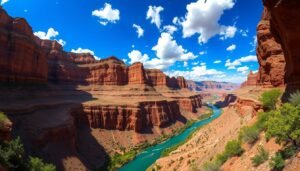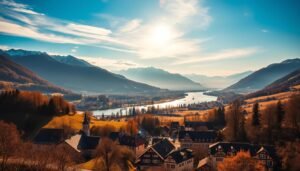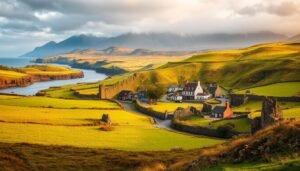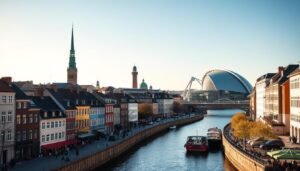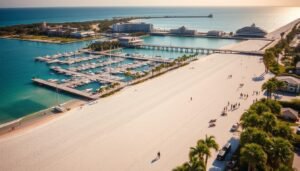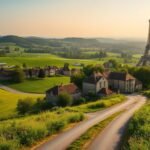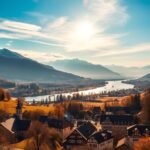Surprising fact: more than 20 million people flock here each year, and I still find quiet corners that feel utterly private.
I write from personal experience as I map a practical, first-person guide across this compact city. I show how I build a one-day trip around San Marco sights, then pivot toward calmer lanes and rooftops.
I’ll cover key entry tips I use: the Basilica has a €3 base fee, timed slots for an extra €3, and interiors light up mid-morning on weekdays. The Campanile elevator runs about €10–15 and the Doge’s Palace ticket sits near €30, with online booking fees and discount cards worth checking.
I favor a water-first rhythm: vaporetto Line 1 at sunset, a gondola ride by dusk, then a rooftop for the Rialto view. This post blends big-ticket stops with simple pleasures—spritz, cicchetti, and quiet bridges—so you’ll find a clear, copyable plan for your visit.
Key Takeaways
- Start early at San Marco for lighter crowds and timed-ticket access.
- Book Campanile and palace tickets online or go off-peak to avoid lines.
- Choose vaporetto for scenery and gondola for romance; plan one ride at sunset.
- Use the free Fondaco rooftop with a slot for stellar Rialto views.
- Mix major sights with quiet alleys and food stops for a balanced day.
My Perfect First Stroll: Get Lost in Venice’s Canals and Backstreets
![]()
I wander without an agenda and let narrow bridges and hidden alleys decide my route. I find this frees me to notice small details that maps miss and to feel the city wake up around me.
Why I ditch the map and let the bridges guide me:
Early morning is my preferred time. There are fewer people, soft light pools in the campos, and gondoliers warm up their voices. I keep my phone tucked away and accept getting a bit lost as part of the fun.
I follow tiny crossings over the canals until I land at a calm place that feels local. I listen for church rehearsals, frames of laundry drifting above water, and a singer floating on a gondola.
I look for signs of older layers—Ponte Chiodo, the last railing-free bridge, always tells me I’ve wandered into a quieter corner. I use a small campo or a little church as a reset point rather than strict navigation.
My soft endpoint is simple: a neighborhood bar where I can pause, sip, and plan the next bit. That pause makes the stroll feel earned and easy.things-to-do-for-kids-near-me
San Marco Highlights: Basilica, Bell Tower, and the Square I Never Skip
![]()
I time my San Marco stop around light and rhythm so the mosaics and rooftops glow at just the right moment. I want the gold inside the basilica to shimmer, and that means aiming for weekday illumination windows between 11:30 a.m. and 12:45 p.m.
St. Mark’s Basilica: Golden mosaics, balcony views, and timing your entry
Entry: the basilica has a €3 base fee; add another €3 for a timed slot booked online. Dress code rules apply and large bags are not allowed, but there is free storage nearby. I always bring a light cover-up and book a timed entry in high season to skip long lines.
Campanile di San Marco: Easy elevator ride to the best city panorama
The bell tower elevator costs about €10–15. I arrive at opening or after 5 p.m. for the shortest queues. From the top I take a slow circle for 360-degree views, and I linger thinking about Galileo’s 1609 demonstration from this very building.
Piazza San Marco: Iconic cafes and when I go to avoid the crowds
I visit Mark Square very early or late to admire Cafe Florian’s facade without paying for a pricey table. I pair this stop with a walk toward the rialto bridge later in the day for a smooth morning-to-evening flow.
My photo priorities: basilica domes, balcony angles, square corners, and rooftop vistas that replicate the views I chase.
| Spot | Cost | Best time |
|---|---|---|
| St. Mark’s Basilica | €3 (timed slot +€3) | 11:30–12:45 weekdays for interior light |
| Campanile di San Marco | €10–15 | Opening or after 5 p.m. (shortest queues) |
| Piazza San Marco | Free (cafés extra) | Very early morning or late evening |
Doge’s Palace and the Bridge of Sighs: History You Can Walk Through

I start my visit at the Doge’s Palace because its grand rooms read like a civic history. The palace is a striking building that shows how power and art shaped the city around San Marco.things-to-do-in-burlington-vt
Practical note: standard entry runs about €30, with reductions if you have a Venice Rolling Card and an extra online booking fee.
Inside the palace: grand rooms and the Doge’s Venice
I book ahead or arrive early so I can linger in the Sala del Maggior Consiglio without rushing. I usually allow 90–120 minutes inside; that gives me time for ceilings, chambers, and the paintings that explain Venice’s political arc.
Crossing the Bridge of Sighs: that famous last view
The Secret Itineraries tour lets me cross the Bridge of Sighs from the inside and watch those narrow windows that frame the final view toward the prison.
I pause outside at Ponte della Paglia and Ponte de Canonica for the classic shots. Crowds thin early and late, and golden hour has been the best light I’ve found for photos and reflection.
“The contrast between opulence and the prison wing makes the visit feel complete.”
- I pair the palace with St. Mark early, then return to the square later for a quieter feel.
- The Secret Itineraries tour deepens the story and includes the Bridge of Sighs crossing; see the Bridge of Sighs tour for booking details.
When I leave, I head toward the waterfront so my next view is fresh and I avoid doubling back.
Grand Canal Magic: How I Ride, Glide, and Soak Up the Views
![]()
I set aside an hour just for the canal so I can watch facades change color as the light shifts. Riding along the grand canal at dusk gives me a clear sense of the city’s rhythm.
Vaporetto Line 1: The scenic “bus” ride I plan around sunset
I time Line 1 near sunset because the palazzi warm under low light and crowds thin. My favorite segment runs from San Marco to the train station; I stand mid-ship where the canal curves for uninterrupted views.new-orleans-things-to-do
Gondola or water bus: choosing the right kind of canal time
I treat a gondola as a special glide—intimate and pricey (citywide rates run about €80 by day and €100 at sunset). A vaporetto is budget-friendly for repeat trips and covers key stops along the water course.
- My rule: gondola on smaller canals for close-up charm; vaporetto on the grand canal for big-shouldered views.
- I plan one leisurely gondola moment and one point-to-point vaporetto ride so transport doubles as a mini-tour.
- If a boat is packed, I wait for the next one rather than craning for a glimpse—better photos and a calmer time.
Iconic Bridges I Always Seek Out
![]()
Bridges stitch the city’s stories, and I chase the ones that reward light and silence.
Rialto Bridge is the oldest span across the Grand Canal. I aim for sunrise or sunset and slip in from side lanes to avoid heavy midday crowds. That timing gives me the hush of morning or the warm glow for quick photos.
Ponte dell’Accademia is a simple wooden bridge with a famous sunset view of Santa Maria della Salute. My ritual is to arrive early, claim a rail spot, and watch boats sketch lines along the canal until the light changes.
Ponte Chiodo and smaller spans show the quieter character I love. No railings, soft steps, and the sound of water underfoot make these crossings feel personal and calm.
I link these in one easy walk—a route that keeps legs fresh and packs a lot of views into a short trip. If a bridge feels overcrowded, I skip it and promise myself I’ll return at a better time rather than force the moment.
Peggy Guggenheim Collection: Modern Art with a Grand Canal Terrace

Peggy’s collection rewards a two-pass visit: I move briskly through the galleries first, then circle back to the works that pull me in. The museum lives in Peggy Guggenheim’s former home, so pieces by Picasso, Dalí, Duchamp, Klee, Magritte, Mondrian, and Pollock feel lived-in rather than staged.
I always end at the simple stone terrace that sits on the grand canal. Here I linger on a favorite bench and watch the boats pass. The rhythm of vaporetti and gondolas makes the view both active and calming.
Mid- to late afternoon is my timing. Warm reflections catch the building façade, and the light holds before it flattens behind tall rooftops. I pair a museum tour with a late lunch nearby so I can return for one last look before I move on for the day.
The fact this is a former home matters. The rooms show how these works once lived with art and objects. That context changes how I read each painting and sculpture.
- I watch for vaporetti chugging, gondolas gliding, and workboats mixing on the water.
- Check temporary exhibits; they often pull me back inside after a terrace pause.
- The setting is quieter than major square sights, so it’s a cultural reset in a busy city itinerary.
“The terrace is a small island of calm where the museum’s energy meets the water.”
| Feature | Why I like it | Best time |
|---|---|---|
| Collections | Works by major 20th-century artists in a home setting | First visit: morning; return in afternoon |
| Terrace | Waterside bench with uninterrupted canal activity | Mid–late afternoon |
| Nearby options | Lunch spots and small galleries for a relaxed follow-up | After museum tour |
Things to Do in Venice Italy Beyond the Big Sights

Evenings away from the main squares reveal how locals live and eat along quieter canals. I head north into Cannaregio for an easy, friendly rhythm: small bars, low-key streets, and fewer tourists.
Cannaregio vibe: feeling local with cicchetti and evening strolls
I plan an evening here by hopping a few bacari for cicchetti and a spritz. I order a mix: fried baccalà, polpette, and a slice of focaccia. That gives me variety without filling up too fast.
My route: three stops, a short pause at a quiet bridge, then a campo for a sit. These brief breaks make the walk feel like discovery rather than a rigid meal plan.
Fondaco dei Tedeschi rooftop: the free Rialto-area view I book ahead
The rooftop is free but you need a reserved slot. I pick a pre-dinner time with flattering light and add padding so I can browse the shop floors below if I arrive early.
- I like the central Grand Canal panorama from up there and I shoot low-angle frames without blocking others.
- Rule of thumb: rooftop, then dinner, then a slow loop back toward where I’m staying. It helps rebalance a busy day of sights.
- If I’ve wandered far, I cut across quieter calli toward my lodging to avoid extra backtracking at night.
“Cannaregio feels like a pause in the day’s pace—small plates, local bars, and calm canals.”
Venetian Ghetto in Cannaregio: Synagogues, Stories, and Respect

I begin my visit at the ghetto’s main square and let the memorials set the tone before I step into any synagogue. The space holds weight; the history of segregation from 1516—curfews, locked gates, even billed surveillance—is visible if you look closely.
Guided or audio tours: how I learn the layered history
I often choose an audio tour because it lets me pause and process at my own rhythm. A guided tour adds context from a local voice, but the audio gives quiet time inside sacred rooms.
My respectful route: start at the square, note memorials, enter synagogues quietly, and watch dress and conduct. Many people still live here; I stay mindful.
- I time visits earlier in the day for focus and fewer crowds.
- I note modest exteriors and surprising interiors; that contrast matters.
- After the tour I sit with a coffee and write one takeaway so the visit stays with me.
| Aspect | Why it matters | Suggested time |
|---|---|---|
| Main square | Memorials frame the history | Arrival |
| Synagogues | Historic interiors, quiet reflection | Mid-morning |
| Tour choice | Audio for pace; guided for detail | Depends on interest |
“Carry one clear takeaway so this visit feels like more than a checkbox.”
Views I Swear By: Where I Go for the Best Cityscapes
![]()
For skyline hunting I pick two spots that always return the clearest city portraits.
San Giorgio Maggiore bell tower: the classic skyline shot
I take vaporetto Line 2 across to Isola di San Giorgio and plan the ride just after first light. The bell tower elevator costs about €3, so I save a little and climb early.best-time-to-visit-banff
Up top I make one slow lap, then pause for a second pass to reframe St. Mark’s Campanile, the Doge’s Palace, and Santa Maria della Salute in a single frame. That composition gives me the signature view I want.
Ponte dell’Accademia and museum terraces: framing the Salute
Ponte dell’Accademia is my sunset bridge. I rest my elbows on the rail where boats line up and the Salute domes catch the low light.
I time this visit so the crowd thins and the light remains soft. My usual sequence is Accademia at dusk, then San Giorgio the next morning. That split gives two perspectives without the tourist crush.
- I allow about 25–40 minutes at the bell tower: elevator, two laps, and quick recompose.
- At the bridge I stay 20–30 minutes for boats, reflections, and steady shots.
- Sequence for a balanced trip: Accademia at sunset, San Giorgio next morning for clearer light.
These two spots anchor my mental map of the city and make later wandering feel intentional.
Eat and Sip Like a Venetian: Cicchetti, Spritz, and Standout Bites
I learned early that a short run of bacari taught me how locals balance a spritz with small plates. This approach keeps the evening light and social while letting me taste more.
Spritz choices matter by time of day. I pick Select for an authentic local note in the afternoon. For balance I order a mezzo e mezzo—half Aperol, half Campari—when I want less sweetness.
How I build a cicchetti plate
I start with classics: fried baccalà, polpette, and a marinated sardine. Then I add one wildcard—maybe a warm crostino or a tossed salad with seafood.
- What I scan for at the counter: high turnover, visible seafood, and warm plates coming out now.
- I use a short food tour early on for orientation, then repeat favorites later on my own.
- My simple sequence: spritz, cicchetti, a little walk, repeat—light, flexible, social.
I plan dinner later than in many U.S. towns. I wait until after 8 p.m. when crowds thin and kitchens settle into a steady pace.
“Stand at the counter, let the crowd guide you, and order what looks freshest.”
| Item | Why I pick it | Best time |
|---|---|---|
| Spritz (Select) | Local flavor, less sweet | Afternoon |
| Mezzo e mezzo | Balanced bitter-sweet mix | Early evening |
| Cicchetti mix | Taste variety without a full meal | Any time I roam |
For a sweet finish I opt for gelato at a low-key shop. I choose quality over flash: look for natural colors and steady lines at the counter, and you’ll find the best last bite.
Mercato di Rialto: Early-Morning Life on the Grand Canal
I wake before sunrise when the market hums and walk straight for the stalls along the Grand Canal.
The market is the city at work: fish, produce, and spices arrive loud and bright. I set my alarm because I like the rhythm—people shouting prices, vendors laughing, and quick bargains before crowds swell.
I make one slow circle first to see what’s freshest, then grab a few food items I can eat the same day. No kitchen? No problem—I pick ripe fruit, salted snacks, and a simple roll that keeps well for a few hours.
I give myself a few extra minutes to slip behind the rialto bridge for a canal-side view in soft morning light. It’s a quiet photo spot before mid-morning energy fades.
I photograph vendors with respect—I ask before close shots and keep interactions light. That keeps the mood friendly and often leads to a smile and a better frame.
- Quick breakfast run: espresso, a pastry, a market stroll, then a short post-walk along the water.
- Mid-morning is my cut-off; stalls slow and the buzz softens.
- Pack purchases loosely so soft fruit won’t get squashed—use a tote or paper bag.
When I leave, I follow a short route toward my next stop so the rest of the day stays tight and efficient. For more on the scene and notes I use, see my strolling through Rialto Market post.
“If you want the market at its best, arrive early and move with the rhythm of the stalls.”
Libreria Acqua Alta: Venice’s Most Photogenic Book Nook
Sometimes a quick look becomes a slow browse, and Libreria Acqua Alta is where that usually happens. I duck inside for a minute and end up hunting through stacked spines that live in gondolas and bathtubs. These clever protections keep used books safe from flood water and give the shop its famous charm.
I watch small rituals here: cats napping on a pile, an English or German title tucked next to Italian paperbacks, and the back courtyard’s book staircase that overlooks a quiet canal. I climb the steps gently, pause for a canal peek, and make sure I do not block the doorway.
- I treat the layout like a scavenger hunt—loops that reveal odd finds.
- I pick a small souvenir: a postcard or a slim book that I can leaf through at a nearby cafe.
- Remember: piles are fragile; handle with care. This is a lived-in shop, not a museum.
“A few minutes here often becomes the best bit of the day.”
After I leave, I slip down nearby lanes for coffee and page through my find. This stop keeps my day varied when big sights have already filled my itinerary, and you’ll find a cozy, human corner of the city that feels wholly original.
Island Day Trip: Burano’s Colors and Murano’s Glass
I map my ferry times so the islands feel like separate worlds, not a rushed checklist.
My one day plan: I head to Murano first for live glass demos before the crowds, then catch the same line onward for Burano when the facades pop at midday.best-hawaiian-island-to-visit/
How I combine both islands without rushing
I watch departures and leave buffer time between boats. That slow rhythm lets me savor each ride and avoid running from dock to dock.
What I buy and the spots I photograph twice
- Glass: I pick small, well-finished pieces—earrings, a paperweight, or a stem—so packing is simple and safe.
- I photograph Burano wide for the street scene, then again tight on shutters, lace, and canal reflections.
- I set a modest budget so I don’t overbuy; shops are everywhere and the best piece waits if you look.
Lunch tip: grab a light midday seat along a quiet canal and watch people drift by while you rest.
“This island loop adds color and craft to my days, then returns me along the grand canal for evening plans.”
Conclusion
, I end most runs with a slow loop that pulls San Marco, the Doge Palace, the Bridge of Sighs, and a Rialto stop into one easy day.
I carve out minutes on a bell tower for wide views, then stand on a quiet bridge at sunset. That pause makes the whole trip feel complete.
Ride the Grand Canal by vaporetto for scope and take a gondola ride for the intimate side of the canal. Book a timed tour where it matters, leave room for food and cicchetti, and save one day for Murano glass and Burano color.
Stay flexible: skip a crowd, circle back later, and finish at the place I always choose—a small bridge, a last look at the water, and a promise to visit again soon.






